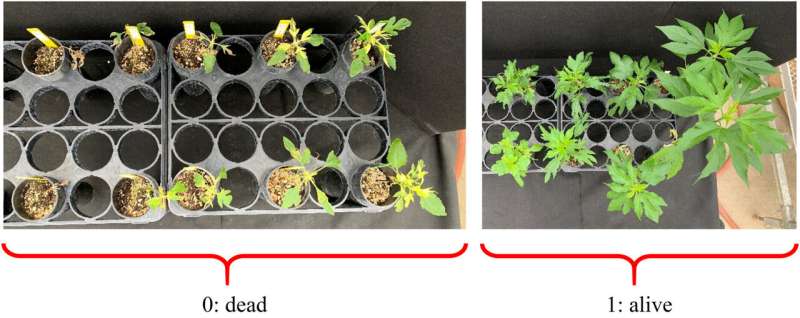This article has been reviewed according to Science X's editorial process and policies. Editors have highlighted the following attributes while ensuring the content's credibility:
fact-checked
peer-reviewed publication
trusted source
proofread
Killing giant ragweed just got harder for some Wisconsin farmers

When giant ragweed takes hold in a crop field, the towering weed reduces yield and sends plumes of its famously allergy-inducing pollen into the air. There are few tools available to thwart the menace, especially for farmers growing non-GMO soybeans. Now, some Wisconsin farmers are left with even fewer options.
Published in Pest Management Science, recent research from the University of Wisconsin–Madison and the University of Illinois Urbana-Champaign shows some giant ragweed populations in Wisconsin have evolved resistance to a crucial class of post-emergence herbicides known as protoporphyrinogen oxidase (PPO) inhibitors (Group 14 herbicides).
"It's hard to control giant ragweed with pre-emergence herbicides, in part because it's a larger seed and can emerge from greater depths. So farmers depend on post-emergence products. For folks growing non-GMO soybean, those POST products are ALS and PPO, and we already have fairly widespread ALS resistance in giant ragweed," said study co-author Pat Tranel, professor in the Department of Crop Sciences in the College of Agricultural, Consumer and Environmental Sciences (ACES) at Illinois.
"Losing PPOs means you're basically out of chemical options," he added.
The results won't surprise some Wisconsin farmers. Study co-author Rodrigo Werle, associate professor and Extension weed scientist at UW-Madison, says farmers started mentioning in 2018 that PPOs weren't working as well.
"We thought they had issues with application timing, that they were missing the ideal window for application," Werle said. "But the growers we were working with are very knowledgeable and did everything by the book. Small plants were regrowing after being sprayed, which can be a sign of resistance."
The research team asked farmers to collect and send seeds from plants in affected fields.
"We evaluated fomesafen (a PPO inhibitor) at 1x and 3x the label rate, and a lot of plants survived. Then we evaluated the dose response for fomesafen and lactofen (another PPO). We determined one population had almost 30-fold resistance to fomesafen and almost four-fold resistance to lactofen," said lead study author Felipe Faleco, a doctoral student at UW-Madison.
Faleco let plants that survived the 1x rate of fomesafen grow to maturity, then collected seeds and handed them off to Tranel, who had previously determined the molecular basis of ALS and PPO resistance in common ragweed, a close relative of the giant variety.
"We sequenced the genes for the PPO target enzyme and found the same mutation that we'd seen in common ragweed," Tranel said. "There were really no other mutations, so that is likely the basis of resistance in giant ragweed, too."
Tranel's group went farther, developing a molecular tool diagnostic labs can use to detect PPO resistance, offering farmers quick answers.
The Wisconsin team also tested for resistance to acetolactate synthase (ALS) inhibitors and glyphosate, finding four populations with resistance to ALS and two populations with resistance to glyphosate. These types of resistance had already been documented in giant ragweed, but the team also found one population with resistance to both.
"For us in Wisconsin, this is the first time we've documented two types of resistance in a single population in giant ragweed," Werle said. "It shows that it's not only waterhemp that is evolving multiple resistance. We also have some other weeds we have to keep an eye on."
Resistance to glyphosate affects GMO soybean growers, who turn to PPO and ALS herbicides in those cases. Similarly, non-GMO growers who can't use glyphosate rely on these chemistries. The authors say with ALS and PPO resistance—essentially, zero chemical options—more non-GMO growers may switch to GMO soybeans.
"Farmers plant non-GMO soybeans for the premiums; there's a financial reason to go that route even though weed control is more difficult," Werle said. "But if a farmer knows they're dealing with this type of resistance, that could prevent them from growing a non-GMO crop in a sustainable or a profitable way."
In addition to the potential impacts on farm management and profits, the findings matter for allergy sufferers.
"As farmers struggle with control, more ragweeds are going to escape and shed pollen," Tranel said. "So if you're living in a semi-rural area with corn and soybean fields around, it's likely there's going to be more pollen in the air."
More information: Felipe A. Faleco et al, Resistance to protoporphyrinogen oxidase inhibitors in giant ragweed (Ambrosia trifida), Pest Management Science (2024). DOI: 10.1002/ps.8349
Journal information: Pest Management Science
Provided by University of Illinois at Urbana-Champaign




















